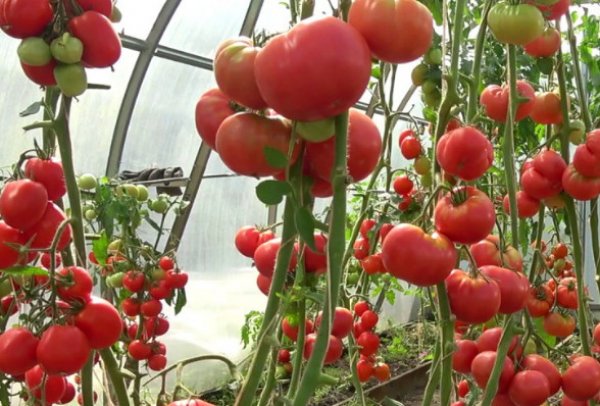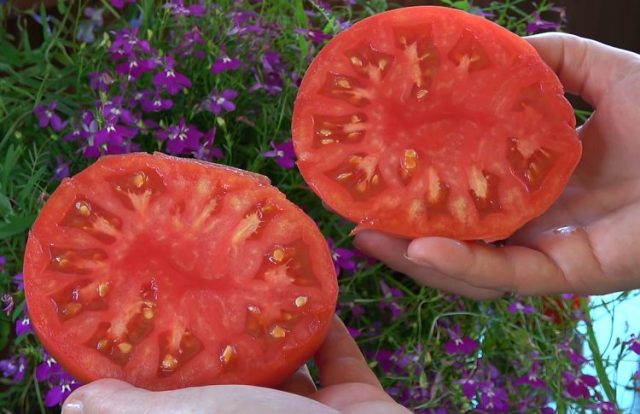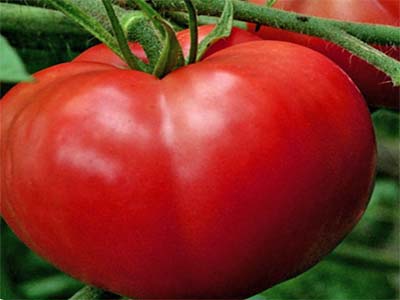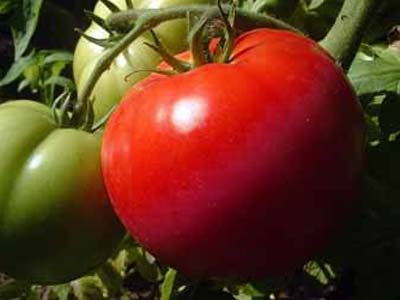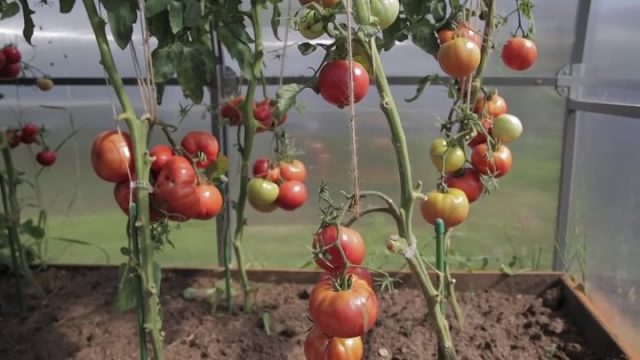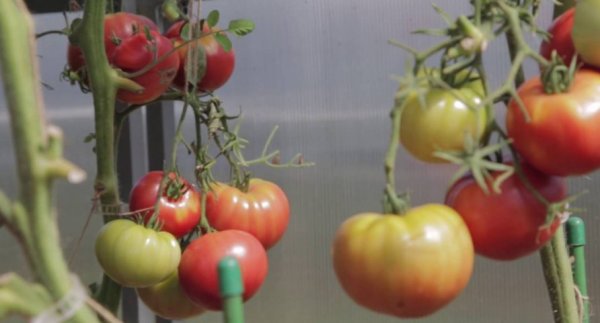Content
Tomato The pride of the feast is one of the newest tomato hybrids bred by the partner agrofirm near Moscow. The variety has already gained respect from summer residents, but it is still interesting to study its characteristics.
Description of tomato variety Pride of the feast
This variety is represented by tall, continuously growing tomatoes that can reach 2 m in height. It has powerful strong branches and a central trunk, does not break even under the weight of massive fruits, although most often the stems are still tied up and attached to supports. The brushes, on which flowers and fruits subsequently appear, develop above 9 leaves and then go every 2 leaves. Each cluster can form 3 - 5 fruit ovaries.
Description of tomato The pride of the feast testifies that the variety is ideal for growing in the middle lane, resistant to diseases and pests, and requires minimal maintenance. In terms of ripening, the variety belongs to the early ones - it is customary to plant seeds already in February, and the harvest from the stems is harvested in just 3 - 3.5 months.
Description of fruits
The fruits of the Pride feast variety have a flat-round shape and a soft ribbing. During ripening, their skin retains a pink color with a green spot around the stalk, fully ripe tomatoes are entirely raspberry, dark pink.
A striking feature of this variety of tomatoes is their large size and significant weight. On average, one fruit has a mass of at least 300 g, and with proper cultivation, fruits can reach 500 g each.
The tomato pulp is firm and juicy, without voids, with small seeds in small seed chambers. Tomatoes ripen simultaneously on the lower and upper parts of the stem, so picking them is especially convenient.
Characteristics of the tomato variety Pride of the feast
In order to make a decision on planting a tomato variety in your country house, it is not enough to be guided only by the taste of the fruit. You need to know what qualities the Pride of the f1 tomato possesses, whether it is difficult to grow it in specific conditions, and how profitable it is to plant it.
Yield
Variety Pride of the feast refers to early ripening tomatoes, since the fruits ripen already 90 or 100 days after planting. The yield is estimated as high - 1 sq. m of seedlings yields from 17 to 19 kg of tomatoes, subject to proper care. At the same time, one bush bears 5 - 6 kg of fruit.
Scope of the fruit
Since the pride of the feast is the red-pink tomatoes, they are not suitable for canning and pickling, for such purposes it is customary to use dark red tomatoes. However, the variety is ideal for salads, casseroles and other fresh uses. Tomatoes of this variety are well transported, therefore they are suitable for growing for sale. Also, you can make healthy juice from juicy fruits.
Disease and pest resistance
Characteristics and description of tomato The pride of the feast claims that it is a highly resistant variety to typical pests and diseases. Plant health problems are rare. In particular, the tomato almost does not suffer from rot, late blight, brown spot and tomato mosaic - all these diseases are typical for tomato crops.
However, proper care requires regular preventive examination of seedlings.When diseases and pests are detected, tomatoes must be treated with Bordeaux liquid, calcium nitrate or copper sulfate. The listed means are sprayed on seedlings, and also added to water for irrigation.
However, the processing of the plant at the first signs of the onset of diseases must be carried out promptly - without waiting for the condition of healthy fruits to deteriorate.
Advantages and disadvantages of the variety
The variety Pride of the feast owes its popularity to its own merits. Namely, the advantages of large red-pink tomatoes include:
- Uniform ripening. All tomatoes on the stem are poured crimson and ripen at the same time, the upper ones are on a par with the lower ones. This makes harvesting especially convenient.
- Fleshy, large size, juiciness of the fruit. Tomatoes are ideal for fresh consumption, they can decorate any table, and their taste is highly appreciated.
- Early ripening and quick ripening. It is customary to plant tomato seedlings of this variety in February, and in order to ripen, the fruits only need 90 - 100 days. Thus, already at the very beginning of summer, beautiful tasty tomatoes can be grown in the greenhouse.
- Good transportability. The skin of tomatoes does not crack, they can be stored for a long time, so they can be sold, including for commercial purposes, and not just consumed for your own pleasure.
As for the shortcomings, two points can be attributed to them.
- The Pride feast tomatoes are not suitable for canning. They can only be consumed fresh, which somewhat narrows the range of applications.
- In the middle lane and northern regions, the variety can only be grown in a greenhouse - the pride of the feast loves high temperatures. Tomatoes are planted in an open garden only in the southern regions.
Despite these disadvantages, the tomato variety Pride of the feast still remains extremely attractive for gardeners. Tomatoes are easy to care for, and yields are generous and tasty.
Features of planting and caring for tomatoes
The Pride of the feast variety is not the most capricious in terms of growing conditions. Even novice gardeners can cope with it, but, of course, you need to know the basic rules for caring for seedlings.
Before planting a variety, you must first of all choose the right soil. Seedlings grow well on neutral acidic, fertile, oxygenated soil. It is best to grow tomatoes in a greenhouse, since they are extremely thermophilic and in most Russian regions they simply will not survive in the garden.
For planting, they acquire young seedlings about 65 days old, or they sow seeds in closed ground on their own - this must be done in February. When the seeds sprout, the tomatoes are planted as follows.
- For 1 sq. m. 2 or 3 tomatoes are placed, forming a small bush, the soil is mulched with straw or hay.
- The distance between individual bushes should be at least 80 cm, and between the rows of tomatoes - half a meter.
- Despite the fact that the Pride of the feast is famous for its strong and thick stems, tomatoes are tied to trellises or props.
- Tomatoes are usually formed into 2 stems, but formation into 1 stem is also allowed - then the fruits will grow especially large and heavy.
It is necessary to control not only the regrowth of stepsons, but also the number of inflorescences on the ovaries - the more there are, the smaller the tomatoes will grow.The optimal number of inflorescences is 4 - 5 on each ovary, and to obtain especially large fruits, it is recommended to leave no more than 3 flowers. As the tomatoes ripen, it is necessary to remove the leaves growing from the bottom of the stem.
Tomatoes Pride of the feast are sensitive to the regime of watering and airing.
- It is necessary to water the seedlings weekly, 1 or 2 times, depending on the rate of drying of the soil, very abundantly. In this case, you need to add water to the root twice a day - in the morning and in the evening. During the period of fruit ripening, watering is recommended to be increased up to 3 - 4 times a week.
- Also, tomatoes in a greenhouse need constant ventilation - you need to let in fresh air every day.
- As the inevitable weeds the soil around the tomatoes is weeded and loosened.
The variety is in dire need of fertilizing - but the frequency and quantity depend on the quality of the soil. If the tomatoes were planted in not the most nutritious soil, then it is recommended to add manure or minerals within 2 weeks after placing the seedlings in the greenhouse.
During the period of active growth of stems, tomatoes of this variety need nitrogen feeding - in the amount of 100 g of dry urea per bucket of water. During flowering and ripening of fruits, you can feed the plant with ash with a high potassium content - the fertilizer will strengthen the stems and promote the growth of large tomatoes.
Conclusion
Tomato The Pride of the Party is a low-maintenance variety suitable for growing in almost any region. But at the same time, the plant bears large, nutritious, very tasty fruits that ripen at the beginning of summer.
Testimonials

